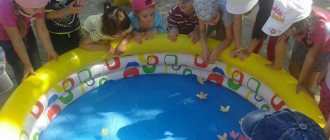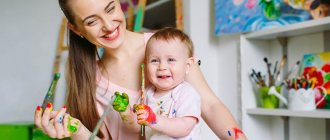The importance of forming ideas about the world around us in young children
Definition 1
Early age is a period in human development that occurs between the ages of 1 and 3 years, characterized by the rapid pace of formation of all psychophysiological processes.
The world around us is very attractive for a young child, as it contains a lot of unknown things that encourage search and the first independent steps and actions.
Active exploration of the surrounding world occurs in the second year of life, when the child has already mastered basic actions such as speaking, walking, etc. He studies and explores everything that comes into his hands and everything that he can reach. All objects surrounding a child represent for him a source of curiosity and one of the first stages of knowledge of the world around him. That is why early age is a fairly important and responsible period in the development of every person.
Are you an expert in this subject area? We invite you to become the author of the Directory Working Conditions
Note 1
The success of his further upbringing, training and development depends on the responsibility with which the adults around him approach the development of a young child. In addition, the foundation of a person’s personality is laid at an early age.
It is important that during early childhood there is an adult next to the child to help him master the world around him. According to L.S. Vygotsky and his followers, only in the “child-adult” system will the child truly develop and be formed as an individual personality.
The role of an adult is undoubtedly very important, but not every adult will be able to have the necessary influence on a child. A child will learn only from an adult whom he trusts, with whom he will be a full participant in the interaction.
Note 2
Currently, Russia has created a very effective and scientifically based system for raising young children in a preschool educational institution.
Finished works on a similar topic
Course work Formation of ideas about the world around us in young children 440 ₽ Abstract Formation of ideas about the world around us in young children 280 ₽ Examination Formation of ideas about the world around us in young children 200 ₽
Receive completed work or specialist advice on your educational project Find out the cost
The education of young children in modern preschool institutions is aimed at the comprehensive and timely formation of the child’s personality. This is achieved by familiarizing young children with the world around them.
Familiarization with the world around the child is carried out in different types of activities:
- Object-tool activity (1-1.5 years).
- Display play activity (1.5-2 years).
- Role-playing game (from 2 years and older).
Note 3
Preschool teachers use these types of activities in combination, thereby stimulating the development of the child at each age level.
The organization of a certain type of activity is primarily aimed at children mastering new knowledge and skills, as well as consolidating existing ones. In the process of this work, children get acquainted with surrounding objects, learn how to operate with them, their purpose and subject content. All this allows you to form a general idea of the world around you.
Familiarizing young children with their surroundings through play.
Job
in
a corner of nature.
Work in a corner of nature is carried out daily during the hours allocated for work. Children observe plants and animals and get used to caring for them, mastering basic work skills. In the first younger group, children only watch how the teacher takes care of the plants. From time to time, all children can work together to clean up a corner of nature.
IV. Contents of classes to familiarize yourself with the subject environment and phenomena of social life
The content of classes on familiarization with the surroundings includes inspections of the premises and area of the kindergarten, observation of the work of adults, the movement of transport, examination of toys, objects, paintings. It is important to include the child in active work from the first minute of the lesson. For these purposes, it is recommended to use an emotional attitude towards the upcoming activity. So, a teacher can show children toys or other demonstration material 3-4 minutes before class and invite them to look at these objects and touch them. In the first minutes of the lesson, children should focus their attention on the phenomenon or object as a whole, then on its main properties. For example, in the didactic game “Where to Put What,” the teacher first demonstrates the objects one by one, asks them to name them, explains their purpose, emphasizes the features, and gives the kids the opportunity to act with them in a variety of ways. Having aroused the children’s interest in the lesson, creating the necessary mood for learning activities, the teacher sets They have specific requirements. For example, in the second part of the didactic game “Where to put what,” children are asked to take an object from the box and arrange them according to their purpose (put the dishes in the cupboard, put the clothes on the shelf in the closet). In the process of such classes, which are carried out based on clarity, it is advisable to combine the influence of the teacher with active actions, speech manifestations of each child, and take into account the emotional reactions of children. To familiarize younger preschoolers with the properties of objects (color, size, shape), games and activities with didactic toys (wooden nesting dolls, inserts, etc.). The educational influence of an adult in these classes takes on a slightly different character. The teacher’s instructions should direct children to learn one specific property. For example, when introducing children to a wooden nesting doll, the teacher helps them identify and name the size of its inserts. In the first part of the lesson, this problem is solved by looking at the nesting dolls that the teacher demonstrates. The assimilation and consolidation of program material occurs in the second part, when children are asked to take a toy and examine it. The child solves the didactic task of correctly taking into account the size of an object while working with a toy, putting a small nesting doll into a large one. Thus, first the teacher gives the children the opportunity to look at the toys, and then switches them to practical operations, during which the child has to compare parts of the object and their signs. Bright, beautiful toys make the child want to look at them longer, so demonstration and handout material that used in classes, must be attractive and elegant. What arouses interest in children, gives them pleasure, is better remembered. A number of pedagogical tasks are solved in games-activities such as “Let’s put the doll to sleep”, “Let’s feed Mashenka”, etc. The uniqueness of these games is that the program content is presented to children in in the form of a series of sequential game actions interconnected by a single situation. Actively working with a doll and other toys, the child practices using words denoting household items, work operations, and memorizing the sequence of certain actions. In classes such as “Guess and Name,” children are introduced to the purpose of objects. To do this, the teacher selects various toys and objects, shows them and asks: “What is this? What is it for? If the children find it difficult to answer, the teacher names, explains and asks the child to repeat. After this the task becomes more difficult. Children are asked to bring and name an object with a specific purpose (“Bring what mom cooks soup and porridge in”). In the process of familiarizing children with the purpose of dishes, clothes, furniture, the teacher organizes an examination of objects grouped according to their use (dining room and tea room dishes, clothes bought for dolls). During the first lessons, children look at different objects and remember their names. In the future, in the classroom, the teacher teaches them to independently determine which group to classify this or that item (dishes, clothes). Then, in the game-activities “Where to put what?”, “Our dishes”, kids group objects according to functionality: dishes are placed on a tray, clothes - in a closet. From a young age, children need to develop an interest in the work of adults. During the first lessons, the child develops ideas about the work of those who make up the child’s immediate environment at home and in kindergarten. Based on the knowledge acquired by children during observations in everyday life, they are trained in recognizing and naming individual work actions (mother sews, washes, irons; the nurse sets a thermometer, looks at the throat; the nanny washes the dishes, etc.). On the following In classes, it is necessary to deepen children’s understanding of individual labor processes, teach them to see the result of labor, achieve an understanding that it is achieved by performing actions in a certain sequence and that this requires appropriate tools and materials. These tasks are solved during organized observations of the work of the janitor (clearing the area from snow) and the nanny (washing dishes), through the game-activities “Masha has a cold”, “Let’s wash the doll’s dress.” For example, the teacher invites the kids to carefully watch how the nanny will wash the cups. At the same time, he asks questions: “What does the nanny do? What does she use to wash the dishes? What does Anna Ivanovna rub the cups with?”, with the help of which she reveals the sequence of operations (the nanny puts the cups in a basin with mustard, rubs them with a washcloth, rinses them in clean water, puts them in the dryer). At the end of the lesson, the teacher consolidates the names of actions and their sequence in the students’ dictionary, and emphasizes the result of the work (“What are the cups like now?”). At the next stage of work, the listed ideas of children are reinforced in the game-activities “Washing dishes for dolls”, “Washing toys”. First, the teacher organizes a play situation, during which the need for clean plates or toys arises, then the children’s attention switches to the washing process. The teacher helps the kids remember what is required for work. Then he asks questions, with the help of which the children reproduce the sequence of work actions. At the end of the lesson, the result and quality of the work performed, who did it and for whom, are emphasized. In order to lead children to understand the names of professions (nanny, janitor), special classes are organized: a tour of the group room, observations. During classes, children answer the teacher’s questions: “Who did all this? Why do you need a nanny (janitor)? What is she/he doing? How does a nanny take care of children? Etc. In order to form ideas about the profession of a driver, children are given basic information about driving a car. In the game-activity “A bear goes to visit the dolls,” the teacher trains students in naming the main actions that the driver performs (gets into the car, turns on the engine, turns the steering wheel). The knowledge acquired by children is consolidated in independent games. The child’s ideas about tools are consolidated in didactic games “Recognize and name”, “Who needs what?”. As the game progresses, children answer the questions: “What is this? Who needs it? Why is this needed?” In the first junior group, children should gain an understanding of vehicles and their purpose, learn to recognize and name them (trucks and cars, bus, tram, trolleybus, train), as well as distinguish and name the main parts of a truck . For this purpose, observations of traffic movement, examination of relevant toys and pictures are organized, didactic games like “Recognize and Name”, game-activities like “What do people drive”, etc. are organized. During art classes, you can ask kids to lay out ready-made forms ( cabin, body, wheels) car. A large part of the work on familiarizing children with their surroundings is given in their free time. It is necessary to constantly draw the attention of children to the work of the adults around them. An experienced teacher will definitely tell the pupils that a delicious lunch was prepared by the cook, that the group room became clean and beautiful because the nanny washed the windows; he will notice a girl coming in in a new dress and explain to the children that her mother sewed the dress, etc. It is important that the teacher draws the children’s attention to what the nanny is doing (changing towels, setting tables for dinner, etc.), included them in the conversation, offering to name what they saw. To consolidate the impressions received, it is advisable to conduct demonstration games from time to time (“Let’s feed the dolls lunch,” “Let’s put the bear to sleep,” etc.). Systematic familiarization of children with the work of adults, the involvement of preschoolers at a level accessible to them in helping their elders allows students to accumulate specific ideas about elementary labor actions, instill respect for the work of others, its result. It is necessary that, simultaneously with the formation of initial ideas about the content of this or that Depending on the type of work, the child developed a positive attitude towards others and a desire to help them. For this purpose, the teacher invites the children to help the janitor sweep the area, and the nanny in putting things in order in the group room. He advises parents to give their children simple tasks to help their elders. Conducting individual conversations with children, the teacher examines the illustrations with them and asks them to tell them what the person depicted in the picture is doing; emphasizes his respectful attitude towards everyone who works. During the year, you should organize targeted walks with children outside the preschool institution, go outside, and draw their attention to vehicles. Children are taught to distinguish and name cars and trucks, trams, buses, trolleybuses, and bicycles. The teacher explains that the car is driven by a driver. Sitting in the cab, he controls it using the steering wheel. It is necessary not only to draw children’s attention to what is happening (a car with sand has driven into the yard, the sand is in the back), but also to teach them to compare objects, identifying similarities and differences between them (a car with sand and a car that brings food to the kindergarten - both trucks, but one of them has a closed body). The teacher supplements the answers, and in case of difficulty, answers himself, asking the child to repeat the name of the object or action. Important tasks of education are the systematic and consistent familiarization of children with the objects of their immediate environment, and the improvement of personal and everyday orientation. So, a child of the third year of life should know his first and last name! names of some group mates, be able to call teachers and nanny by name and patronymic. These skills are simply and naturally formed where a friendly environment is created in the group, when adults are attentive to children, talk to them a lot, and use every opportunity to train children in communication skills with elders and peers. It is important that the teacher and nanny call each other by name and patronymic. Regular processes, as well as independent games of children, moments of their communication with each other should be used as fully as possible to expand ideas about household items (clothing, furniture, dishes, toys) , for speech development. The teacher needs to systematically communicate with each child: help name the objects that surround him; instruct someone to take a toy to a place or give it to someone; draw the baby’s attention to the phenomena of life around him and maintain interest in them; talk about events that took place before. As a result of purposeful work, the child acquires vital ideas about the environment. Along with this, he develops sensory and mental abilities. By getting acquainted with objects, the child practically learns their properties and qualities (size, shape, color, taste, position in space, material, etc.). He develops the ability to generalize (ball, ball - round, balls - big and small, red and blue). Children master the ability to group objects according to a certain characteristic, property, or purpose (for example, selecting everything necessary for bathing a doll).




